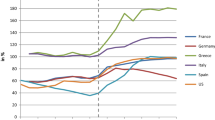Abstract
The crises suffered in 1992/93 by the old EMS with its narrow exchange rate bands were largely due to the fact that the central banks' unlimited spot intervention obligations held little credibility for speculators. How can a credible exchange rate guarantee be achieved by improving the intervention mechanism?
Similar content being viewed by others
References
Cf. Christian Hacke: Von Kennedy bis Reagan-Grundzüge der amerikanischen Außenpolitik 1960–1984, Stuttgart 1984, pp. 33 ff.; also Helmut Schmidt: Strategie des Gleichgewichts, Stuttgart 1969, pp. 62 ff.
Olaf Sievert: Deutsche Geldpolitik zwischen nationalem Interesse und europäischer Rücksichtsnahme?, in: Auszüge aus Presseartikeln der Deutschen Bundesbank, Nr. 91 (1993), p. 7.
“Großbritanniens Probleme mit dem Währungsverbund”, in: Neue Zürcher Zeitung, 29./30.9.1992.
For the way the EMS works cf.: Commission of the European Communities: The European Monetary System, Brussels 1979; also the systematic presentation in: Peter Bofinger: Festkurssysteme und geldpolitische Koordination, Baden-Baden 1991, pp. 337–377.
Cf. Barry Eichengreen, Charles Wyplosz: The unstable EMS, Brookings Papers on Economic Activity, 1:1993, Washington DC, pp. 109f.
Cf. Wolfgang Stützel: Über Währungsspekulaten und den Umgang mit denselben, in: Wolfgang Stützel: Währung in weltoffener Wirtschaft—Lehrstücke der Währungspolitik unter der Herausforderung des Tages, Frankfurt 1973, p. 137; also the table in this paper taken from: Barry Eichengreen, Charles Wyplosz, loc. cit. The unstable EMS, Brookings Papers on Economic Activity, 1∶1993, Washington DC, pp. 109 f
Lans Hörngren, Hans Lindberg: The Struggle to Turn the Swedish Krona into a Hard Currency, Sveriges Riksbank, Arbetsrapport No. 8, Stockholm 1993, p. 23
Cf. Peter Bofinger, loc cit. Festkurssysteme und geldopolitische Koordination, Baden-Baden 1991, pp. 88–176 and pp. 337–377; also Robert Vehrkamp: The European Monetary System during the phase of transition to European Monetary Union, Economic Papers (European Commission), No. 108, July 1994, pp. 9–44. For a similar approach cf. Ronald I. McKinnon: The Rules of the Game: International Money in Historical Perspective, in: Journal of Economic Literature, Vol. 31 (March 1993), pp. 1–44.
for a description of the realignment procedure cf. Andreas Kees: The Monetary Committee of the European Community, in: Kredit und Kapital 2/1987, pp. 258–268. For the interpretation of this situtation from the point of view of a hard currency central bank cf. Fritz Scholl: The domain of speculators or a place to correct untenable exchange rate relationships, in: The Treasurer, October 1993, p. 55.
For the principles of forward intervention theory cf. Egon Sohmen: Wechselkurs und Währungsordnung, Tübingen 1973. pp. 83–131; also the stimulating illustration and interpretation of the relevant context in Wolfram Engels: Notenbanktechnik: Instrumente und Verfahren der monetären Stabilitätspolitik, Frankfurt/Main 1979, pp. 24–53.
For a general illustration of the mechanics of speculative attacks on the exchange rate promises in fixed rate systems cf.: Morris Goldstein et al.: International Capital Markets-Part I: Exchange Rate Management and International Capital Flows, International Monetary Fund, Washington 1993; also, particularly informative on the course of the autumn 1992 EMS crisis: Group of Ten: International Capital Markets and Foreign Exchange Markets—A Report to the Ministers and Governors, Rome 1993.
Leland B. Yeager: International Monetary Relations: Theory, History and Policy, New York 1976, p. 280.
Cf. Peter Fischer-Erlach: Handel und Kursbildung am Devisenmarkt, Stuttgart 1991, pp. 82–88; also the discussion of the relevant literature in Leland B. Yeager, loc cit., International Monetary Relations: Theory, History and Policy, New York 1976, pp. 279–285
Author information
Authors and Affiliations
Rights and permissions
About this article
Cite this article
Vehrkamp, R. De facto Monetary Union through forward interventions. Intereconomics 30, 111–116 (1995). https://doi.org/10.1007/BF02927265
Issue Date:
DOI: https://doi.org/10.1007/BF02927265




